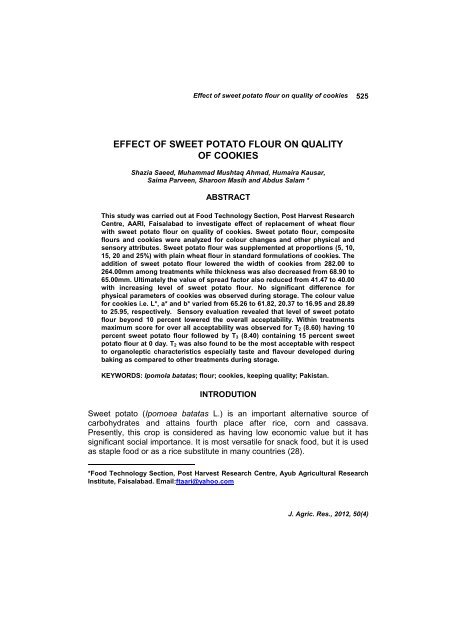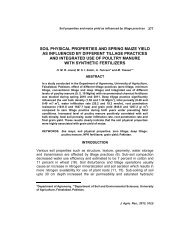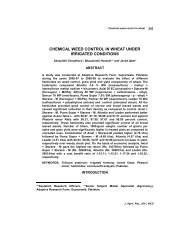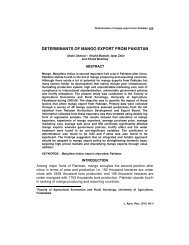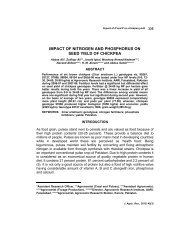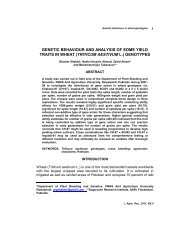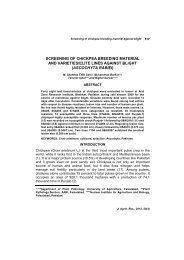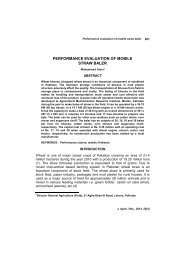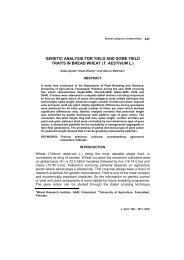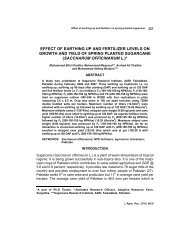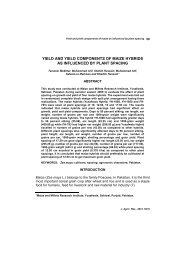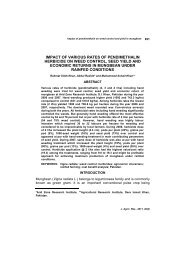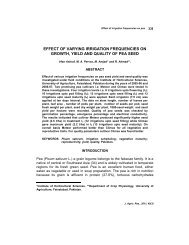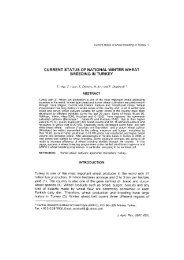Effect of Sweet Potato Flour on Quality of Cookies Shazia Saeed ...
Effect of Sweet Potato Flour on Quality of Cookies Shazia Saeed ...
Effect of Sweet Potato Flour on Quality of Cookies Shazia Saeed ...
Create successful ePaper yourself
Turn your PDF publications into a flip-book with our unique Google optimized e-Paper software.
<str<strong>on</strong>g>Effect</str<strong>on</strong>g> <str<strong>on</strong>g>of</str<strong>on</strong>g> sweet potato flour <strong>on</strong> quality <str<strong>on</strong>g>of</str<strong>on</strong>g> cookies<br />
525<br />
EFFECT OF SWEET POTATO FLOUR ON QUALITY<br />
OF COOKIES<br />
<strong>Shazia</strong> <strong>Saeed</strong>, Muhammad Mushtaq Ahmad, Humaira Kausar,<br />
Saima Parveen, Sharo<strong>on</strong> Masih and Abdus Salam *<br />
ABSTRACT<br />
This study was carried out at Food Technology Secti<strong>on</strong>, Post Harvest Research<br />
Centre, AARI, Faisalabad to investigate effect <str<strong>on</strong>g>of</str<strong>on</strong>g> replacement <str<strong>on</strong>g>of</str<strong>on</strong>g> wheat flour<br />
with sweet potato flour <strong>on</strong> quality <str<strong>on</strong>g>of</str<strong>on</strong>g> cookies. <str<strong>on</strong>g>Sweet</str<strong>on</strong>g> potato flour, composite<br />
flours and cookies were analyzed for colour changes and other physical and<br />
sensory attributes. <str<strong>on</strong>g>Sweet</str<strong>on</strong>g> potato flour was supplemented at proporti<strong>on</strong>s (5, 10,<br />
15, 20 and 25%) with plain wheat flour in standard formulati<strong>on</strong>s <str<strong>on</strong>g>of</str<strong>on</strong>g> cookies. The<br />
additi<strong>on</strong> <str<strong>on</strong>g>of</str<strong>on</strong>g> sweet potato flour lowered the width <str<strong>on</strong>g>of</str<strong>on</strong>g> cookies from 282.00 to<br />
264.00mm am<strong>on</strong>g treatments while thickness was also decreased from 68.90 to<br />
65.00mm. Ultimately the value <str<strong>on</strong>g>of</str<strong>on</strong>g> spread factor also reduced from 41.47 to 40.00<br />
with increasing level <str<strong>on</strong>g>of</str<strong>on</strong>g> sweet potato flour. No significant difference for<br />
physical parameters <str<strong>on</strong>g>of</str<strong>on</strong>g> cookies was observed during storage. The colour value<br />
for cookies i.e. L*, a* and b* varied from 65.26 to 61.82, 20.37 to 16.95 and 28.89<br />
to 25.95, respectively. Sensory evaluati<strong>on</strong> revealed that level <str<strong>on</strong>g>of</str<strong>on</strong>g> sweet potato<br />
flour bey<strong>on</strong>d 10 percent lowered the overall acceptability. Within treatments<br />
maximum score for over all acceptability was observed for T 2 (8.60) having 10<br />
percent sweet potato flour followed by T 3 (8.40) c<strong>on</strong>taining 15 percent sweet<br />
potato flour at 0 day. T 2 was also found to be the most acceptable with respect<br />
to organoleptic characteristics especially taste and flavour developed during<br />
baking as compared to other treatments during storage.<br />
KEYWORDS: Ipomola batatas; flour; cookies, keeping quality; Pakistan.<br />
INTRODUTION<br />
<str<strong>on</strong>g>Sweet</str<strong>on</strong>g> potato (Ipomoea batatas L.) is an important alternative source <str<strong>on</strong>g>of</str<strong>on</strong>g><br />
carbohydrates and attains fourth place after rice, corn and cassava.<br />
Presently, this crop is c<strong>on</strong>sidered as having low ec<strong>on</strong>omic value but it has<br />
significant social importance. It is most versatile for snack food, but it is used<br />
as staple food or as a rice substitute in many countries (28).<br />
*Food Technology Secti<strong>on</strong>, Post Harvest Research Centre, Ayub Agricultural Research<br />
Institute, Faisalabad. Email:ftaari@yahoo.com<br />
J. Agric. Res., 2012, 50(4)
526<br />
S. <strong>Saeed</strong> et al.<br />
<str<strong>on</strong>g>Sweet</str<strong>on</strong>g> potato has a large potential to be used as food in developing nati<strong>on</strong>s<br />
with limited resources because <str<strong>on</strong>g>of</str<strong>on</strong>g> short maturity time, ability to grow under<br />
diverse climatic c<strong>on</strong>diti<strong>on</strong>s and <strong>on</strong> less fertile soil. <str<strong>on</strong>g>Sweet</str<strong>on</strong>g> potato flour can<br />
serve as a source <str<strong>on</strong>g>of</str<strong>on</strong>g> energy and carbohydrates, beta carotene (pro-vitamin<br />
A), minerals (Ca, P, Fe and K) and dietary fibre which can add natural<br />
sweetness, colors and flavour to processed food products (24, 27).<br />
Traditi<strong>on</strong>ally cookies are made from wheat flour but small quantities <str<strong>on</strong>g>of</str<strong>on</strong>g> other<br />
cereal flours or starches can also be added to give special flavour or<br />
structural properties. In recent years the interest in high fibre c<strong>on</strong>tent in foods<br />
has greatly increased. High dietary fibre supplemented cookies have been<br />
prepared by replacing wheat flour with cereal by-products like corn bran, rice<br />
bran or barley husk (4, 8, 22).<br />
Most <str<strong>on</strong>g>of</str<strong>on</strong>g> the research has been focused <strong>on</strong> the development <str<strong>on</strong>g>of</str<strong>on</strong>g> new products<br />
using sweet potato flour rather than <strong>on</strong> efficient methods to produce and<br />
store the flour (10). Hagenimana et al. (7) reported that additi<strong>on</strong> <str<strong>on</strong>g>of</str<strong>on</strong>g> orangefleshed<br />
sweet potato in buns, chapattis and mandazis greatly increased the<br />
c<strong>on</strong>tent <str<strong>on</strong>g>of</str<strong>on</strong>g> total carotenoids in these products. Additi<strong>on</strong> <str<strong>on</strong>g>of</str<strong>on</strong>g> various proporti<strong>on</strong><br />
<str<strong>on</strong>g>of</str<strong>on</strong>g> sweet potato flour in wheat flour can increase the nutritive values in terms<br />
<str<strong>on</strong>g>of</str<strong>on</strong>g> fibre and carotenoids. This also helps lower the gluten level and prevent<br />
from coeliac disease (23). Blending <str<strong>on</strong>g>of</str<strong>on</strong>g> sweet potato flour with wheat flour can<br />
be used for producti<strong>on</strong> <str<strong>on</strong>g>of</str<strong>on</strong>g> bakery goods with improved functi<strong>on</strong>al properties<br />
and reduced retro-graduati<strong>on</strong>, staling rate and producti<strong>on</strong> time (1) and also<br />
helps in making a good baking product with increased ec<strong>on</strong>omic value.<br />
Baking industry in Pakistan is flourishing day by day. A wide variety <str<strong>on</strong>g>of</str<strong>on</strong>g> baked<br />
goods is available in market to fulfill c<strong>on</strong>sumer demand for nutriti<strong>on</strong>al<br />
requirement. Now people are becoming more c<strong>on</strong>scious about their health<br />
and nutriti<strong>on</strong>. They require foods that are c<strong>on</strong>venient with good taste,<br />
reas<strong>on</strong>able price and carry favorable nutriti<strong>on</strong>al image. Besides other baked<br />
products, cookies are <strong>on</strong>e <str<strong>on</strong>g>of</str<strong>on</strong>g> the most popular bakery products, widely<br />
c<strong>on</strong>sumed due to its ready-to-eat nature, good nutriti<strong>on</strong>al quality, low cost<br />
and l<strong>on</strong>ger shelf life that has also been enriched with dietary fibre (3).<br />
Biscuits are ideal for their nutriti<strong>on</strong>al value, palatability, compactness and<br />
c<strong>on</strong>venience. These are also important food reserves for explorati<strong>on</strong>, in war<br />
or flood and as an aid for the famished people. Many travelers and explorers<br />
have, over the centuries, been grateful to humble cookies for these<br />
properties. Indeed, cookies still form a significant comp<strong>on</strong>ent <str<strong>on</strong>g>of</str<strong>on</strong>g> many<br />
emergency food supplies.<br />
The present research was c<strong>on</strong>ducted to find out most suitable proporti<strong>on</strong> <str<strong>on</strong>g>of</str<strong>on</strong>g><br />
sweet potato flour and wheat flour for cookies preparati<strong>on</strong> keeping in view its<br />
physical and sensory parameters.<br />
J. Agric. Res., 2012, 50(4)
<str<strong>on</strong>g>Effect</str<strong>on</strong>g> <str<strong>on</strong>g>of</str<strong>on</strong>g> sweet potato flour <strong>on</strong> quality <str<strong>on</strong>g>of</str<strong>on</strong>g> cookies<br />
527<br />
MATERIALS AND METHODS<br />
This study was c<strong>on</strong>ducted in Food Technology Secti<strong>on</strong>, Post Harvest<br />
Research Centre, AARI, Faisalabad, Pakistan during the year 2010. <str<strong>on</strong>g>Sweet</str<strong>on</strong>g><br />
potato and other ingredients for the preparati<strong>on</strong> <str<strong>on</strong>g>of</str<strong>on</strong>g> cookies e.g. wheat flour,<br />
sugar, shortening, baking powder and eggs were purchased from local<br />
market. <str<strong>on</strong>g>Sweet</str<strong>on</strong>g> potato roots were washed and trimmed to make them free<br />
from soil and other foreign materials, rotten part or insect damage, etc.<br />
These were peeled and cut into thin slices manually. Slices were then<br />
immersed in soluti<strong>on</strong> c<strong>on</strong>taining potassium meta-bisulphite (0.5%) for 15<br />
minutes. <str<strong>on</strong>g>Sweet</str<strong>on</strong>g> potato slices were dined <strong>on</strong> perforated wooden trays in a<br />
tunnel dehydrator at 60 o C till 10 percent moisture c<strong>on</strong>tent. The dried chips<br />
were milled into flour using the grinder and passed through 80 mesh sieve to<br />
obtain flour <str<strong>on</strong>g>of</str<strong>on</strong>g> uniform size. Flow diagram for preparati<strong>on</strong> <str<strong>on</strong>g>of</str<strong>on</strong>g> sweet potato<br />
flour cookies is given below:-<br />
SWEET POTATO<br />
GRADING AND WASHING<br />
PEELING<br />
SLICING<br />
TREATMENT<br />
DRYING (55°C)<br />
GRINDING<br />
SIEVING (size 80 mesh)<br />
INGREDIENTS MIXING<br />
KNEADING<br />
SHEETING<br />
CUTTING<br />
BAKING<br />
PACKING and STORAGE<br />
Fig.1. Flow diagram for preparati<strong>on</strong> <str<strong>on</strong>g>of</str<strong>on</strong>g> sweet potato flour cookies<br />
J. Agric. Res., 2012, 50(4)
528<br />
S. <strong>Saeed</strong> et al.<br />
Wheat flour and sweet potato flour were used in different proporti<strong>on</strong>s viz.<br />
100:0 (T 0 ), 95:5 (T 1 ), 90:10 (T 2 ), 85:15 (T 3 ), 80:20 (T 4 ) and 75:25 (T 5 ).<br />
<strong>Cookies</strong> were prepared with some modificati<strong>on</strong>s according to the method as<br />
described in AACC (3) with the formulati<strong>on</strong> as given in Table 1.<br />
Table 1. Formulati<strong>on</strong> for cookies.<br />
Ingredients<br />
Wheat flour<br />
Sugar<br />
Shortening<br />
Baking powder<br />
Eggs<br />
Water<br />
Quantity<br />
200 g<br />
100 g<br />
100 g<br />
3 g<br />
1 (in No)<br />
15 – 20 mL<br />
After weighing the ingredients accurately, fat and sugar were creamed in a<br />
mixer with a flat beater for two minutes at slow speed, followed by additi<strong>on</strong> <str<strong>on</strong>g>of</str<strong>on</strong>g><br />
eggs. Creaming c<strong>on</strong>tinued till foaming was occurred. The wheat flour, baking<br />
powder and water were added to the creaming mass and mixed to a<br />
homogeneous mixture for five miniutes at high speed. Finally, flour c<strong>on</strong>taining<br />
various proporti<strong>on</strong>s <str<strong>on</strong>g>of</str<strong>on</strong>g> sweet potato flour, which had been sieved twice with<br />
baking powder was added and mixed for three minutes at medium speed.<br />
The dough was then sheeted to a thickness <str<strong>on</strong>g>of</str<strong>on</strong>g> 3.00 mm with the help <str<strong>on</strong>g>of</str<strong>on</strong>g> a<br />
rolling pin and aluminum frame <str<strong>on</strong>g>of</str<strong>on</strong>g> standard height. The cookies were cut with<br />
a cookies die <str<strong>on</strong>g>of</str<strong>on</strong>g> 35 mm diameter and transferred to a lightly greased baking<br />
tray at a proper distance. The cookies were baked at 218 o C in baking oven<br />
for 10-12 minutes. After baking, cookies were cooled at room temperature<br />
and packed in air tight polythene bags for further storage studies.<br />
Proximate analysis <str<strong>on</strong>g>of</str<strong>on</strong>g> sweet potato flour and plain wheat flour<br />
<str<strong>on</strong>g>Sweet</str<strong>on</strong>g> potato flour and plain wheat flour were analyzed for moisture, protein,<br />
ash, fat and crude fibre and nitrogen free extract, according to the methods<br />
described in AACC (1).<br />
Colour (Lab)<br />
The colour values <str<strong>on</strong>g>of</str<strong>on</strong>g> flour and cookies were measured using the L*, a* and b*<br />
colour space (CIE-LAB Space) with Color Tech-PCM (USA). The L* value<br />
indicates (lightness), a* and b* values are chromaticity coordinates (a* from<br />
red (+) to green (-) and b*, from yellow (-) to blue (-).<br />
J. Agric. Res., 2012, 50(4)
<str<strong>on</strong>g>Effect</str<strong>on</strong>g> <str<strong>on</strong>g>of</str<strong>on</strong>g> sweet potato flour <strong>on</strong> quality <str<strong>on</strong>g>of</str<strong>on</strong>g> cookies<br />
529<br />
Physical analysis <str<strong>on</strong>g>of</str<strong>on</strong>g> cookies<br />
The packed cookies, prepared from different levels <str<strong>on</strong>g>of</str<strong>on</strong>g> sweet potato flour were<br />
placed at room temperature. Physical characteristics <str<strong>on</strong>g>of</str<strong>on</strong>g> cookies like width,<br />
thickness and spread factor were measured fortnightly for 90 days storage<br />
according to the methods described in AACC (3).<br />
Width (W): Width <str<strong>on</strong>g>of</str<strong>on</strong>g> cookies was measured by placing six cookies<br />
horiz<strong>on</strong>tally (edge to edge) and rotated at 90 o angle for duplicate reading.<br />
Thickness (T): The thickness <str<strong>on</strong>g>of</str<strong>on</strong>g> cookies was measured by placing six<br />
cookies <strong>on</strong> <strong>on</strong>e another and the duplicate reading was recorded.<br />
Spread factor (SF): The spread factor was calculated according to the<br />
formula SF = (W/T x CF) x 10 where CF=Correcti<strong>on</strong> factor at c<strong>on</strong>stant<br />
atmospheric pressure (10.0 in this case).<br />
Sensory evaluati<strong>on</strong><br />
Characteristics like colour, flavour, taste and overall acceptability were<br />
evaluated by a panel <str<strong>on</strong>g>of</str<strong>on</strong>g> five semi-trained judges selected from Food<br />
Technology Secti<strong>on</strong>, AARI, Faisalabad. Sensory characteristics like colour,<br />
flavour, taste and overall acceptability were measured at 15 days interval<br />
upto 90 days, according to the procedure described by Meilgaard et al. (14).<br />
Statistical analysis<br />
The data obtained were statistically analyzed for analysis <str<strong>on</strong>g>of</str<strong>on</strong>g> variance<br />
(ANOVA) by using 2-factorial completely randomized design using LSD at<br />
P≤0.05 according to the method described by Steel et al. (21).<br />
RESULTS AND DISCUSSION<br />
Proximate analysis <str<strong>on</strong>g>of</str<strong>on</strong>g> sweet potato flour and plain wheat flour<br />
Proximate analysis (Table 2) indicated that moisture c<strong>on</strong>tent <str<strong>on</strong>g>of</str<strong>on</strong>g> sweet potato<br />
flour was 8.7 percent with high fibre (8.5%) but very low protein c<strong>on</strong>tents<br />
(3.1%). The ash percentage in sweet potato flour was recorded upto 2.1<br />
percent with 76.39 percent nitrogen free extract (NFE). These results are in<br />
close agreement with findings <str<strong>on</strong>g>of</str<strong>on</strong>g> Singh et al. (20) who have reported 8.7<br />
percent moisture c<strong>on</strong>tents, 2.3 percent protein, 9.4 percent fibre and 1.56<br />
J. Agric. Res., 2012, 50(4)
530<br />
S. <strong>Saeed</strong> et al.<br />
Table 2. Proximate analysis <str<strong>on</strong>g>of</str<strong>on</strong>g> sweet potato flour and plain wheat flour.<br />
Sr. No Compositi<strong>on</strong> (%) <str<strong>on</strong>g>Sweet</str<strong>on</strong>g> potato flour Plain wheat flour<br />
1 Moisture 8.7 11.9+ 0.1<br />
2 Protein 3.1 11 + 0.07<br />
3 Fat 1.21 1.68 + 0.06<br />
4 Fibre 8.5 0.07 + 0.08<br />
5 Ash 2.1 0.68 + 0.01<br />
6 NFE 76.39 74.67 + 0.1<br />
percent ash in sweet potato flour. Mebpa et al. (13) also reported similar<br />
results regarding compositi<strong>on</strong> <str<strong>on</strong>g>of</str<strong>on</strong>g> plain wheat flour i.e. 11.31 percent moisture,<br />
12.86 percent protein, 1.40 percent lipids, 0.82 percent crude fat and 0.46<br />
percent ash.<br />
Colour analysis <str<strong>on</strong>g>of</str<strong>on</strong>g> flour blends and cookies<br />
<str<strong>on</strong>g>Effect</str<strong>on</strong>g> <str<strong>on</strong>g>of</str<strong>on</strong>g> sweet potato flour <strong>on</strong> colour values <str<strong>on</strong>g>of</str<strong>on</strong>g> flour blends and cookies was<br />
significant (Tables 3). L* value <str<strong>on</strong>g>of</str<strong>on</strong>g> flour blends decreased significantly from<br />
95.75 to 84.96 with increasing the proporti<strong>on</strong> <str<strong>on</strong>g>of</str<strong>on</strong>g> sweet potato flour.<br />
However this value decreased from 65.26 to 61.82 in the cookies. The value<br />
<str<strong>on</strong>g>of</str<strong>on</strong>g> a* increased from 2.62 to 5.92 with increasing the proporti<strong>on</strong> <str<strong>on</strong>g>of</str<strong>on</strong>g> sweet<br />
potato flour in flour blends. In cookies the results showed a decline <str<strong>on</strong>g>of</str<strong>on</strong>g> a*<br />
value from 20.37 to 16.95 (Table 3). It indicated that redness in flour blends<br />
increased with the additi<strong>on</strong> <str<strong>on</strong>g>of</str<strong>on</strong>g> sweet potato flour while in cookies redness<br />
decreased. The b* value which shows yellowness <str<strong>on</strong>g>of</str<strong>on</strong>g> flour increased<br />
significantly from 9.84 to 14.65 while in cookies this value reduced from<br />
28.89 to 25.95 with increasing the proporti<strong>on</strong> <str<strong>on</strong>g>of</str<strong>on</strong>g> sweet potato flour (Table 3).<br />
The yellow-orange colour <str<strong>on</strong>g>of</str<strong>on</strong>g> sweet potato flour was due to the presence <str<strong>on</strong>g>of</str<strong>on</strong>g><br />
carotenoid pigments, which affected the red-green chromaticity (24). The<br />
results coincide with those <str<strong>on</strong>g>of</str<strong>on</strong>g> Singh et al. (19) who observed similar pattern in<br />
colour changes in the preparati<strong>on</strong> <str<strong>on</strong>g>of</str<strong>on</strong>g> sweet potato flour incorporated cookies<br />
at different proporti<strong>on</strong>s.<br />
Table 3. <str<strong>on</strong>g>Effect</str<strong>on</strong>g> <str<strong>on</strong>g>of</str<strong>on</strong>g> sweet potato flour <strong>on</strong> color <str<strong>on</strong>g>of</str<strong>on</strong>g> flour blends and cookies.<br />
Color values <str<strong>on</strong>g>of</str<strong>on</strong>g> flour blends Color values <str<strong>on</strong>g>of</str<strong>on</strong>g> cookies<br />
Wheat flour sweet: L* a* b* L* a* b*<br />
potato flour<br />
100:0 95.75d 2.62a 9.84a 65.26d 20.37d 28.89d<br />
95:5 93.69c 3.25b 10.42ab 64.51c 20.08d 28.26d<br />
90:10 90.78ab 3.98bc 11.87b 63.71bc 19.25cd 27.92cd<br />
85:15 89.71bc 4.56c 12.92c 63.05bc 18.76c 27.43c<br />
80:20 87.94b 5.03cd 13.32cd 62.35b 17.26b 26.65b<br />
75:25 84.96a 5.92d 14.65d 61.82a 16.95a 25.95a<br />
The values denoted by different letters in the same column are significantly different<br />
(p
<str<strong>on</strong>g>Effect</str<strong>on</strong>g> <str<strong>on</strong>g>of</str<strong>on</strong>g> sweet potato flour <strong>on</strong> quality <str<strong>on</strong>g>of</str<strong>on</strong>g> cookies<br />
531<br />
The flour blends were analyzed for colour changes in each treatment. It was<br />
observed that with gradual increase in sweet potato flour there was a<br />
reducti<strong>on</strong> in L* value while a* and b* values were gradually increased with the<br />
additi<strong>on</strong> <str<strong>on</strong>g>of</str<strong>on</strong>g> sweet potato flour. Similar results are also found by Singh et al.<br />
(19) while studying effect <str<strong>on</strong>g>of</str<strong>on</strong>g> incorporating sweet potato flour in wheat flour <strong>on</strong><br />
quality characteristics <str<strong>on</strong>g>of</str<strong>on</strong>g> cookies.<br />
Physical characteristics<br />
Width (W): Analytical results indicated (Fig. 1) that different levels <str<strong>on</strong>g>of</str<strong>on</strong>g> sweet<br />
potato flour showed significant effect <strong>on</strong> the width <str<strong>on</strong>g>of</str<strong>on</strong>g> cookies. A decreasing<br />
trend was found with the increase <str<strong>on</strong>g>of</str<strong>on</strong>g> sweet potato flour level. At 0 day<br />
storage, T 0 exhibited maximum width (288mm) followed by T 1 (282mm), while<br />
T 5 exhibited minimum width (264mm) followed by T 4 (269mm). It is clear that<br />
enhancement in level <str<strong>on</strong>g>of</str<strong>on</strong>g> sweet potato flour significantly decreased the width<br />
<str<strong>on</strong>g>of</str<strong>on</strong>g> cookies which is attributed to an increase in fibre c<strong>on</strong>tents due to additi<strong>on</strong><br />
<str<strong>on</strong>g>of</str<strong>on</strong>g> sweet potato flour, a rich source <str<strong>on</strong>g>of</str<strong>on</strong>g> dietary fibre.<br />
Width (mm )<br />
290<br />
285<br />
280<br />
275<br />
270<br />
265<br />
260<br />
255<br />
250<br />
0 15 30 45 60 75 90<br />
T0 (WF100%:SPF 0%)<br />
T1 (WF95%:SPF 5%)<br />
T2 (WF90%:SPF 10%)<br />
T3 (WF85%:SPF 15%)<br />
T4 (WF80%:SPF 20%)<br />
T5 (WF75%:SPF 25%)<br />
Storage Days<br />
Fig. 1. <str<strong>on</strong>g>Effect</str<strong>on</strong>g> <str<strong>on</strong>g>of</str<strong>on</strong>g> treatments and storage <strong>on</strong> width <str<strong>on</strong>g>of</str<strong>on</strong>g> cookies<br />
However, storage exhibited n<strong>on</strong>-significant effect <strong>on</strong> the width <str<strong>on</strong>g>of</str<strong>on</strong>g> cookies.<br />
Sharif et al. (17) prepared fibre and mineral enriched de-fatted rice bran<br />
supplemented cookies. They observed a decreasing trend in width from<br />
44.15 to 36.53mm with percent increase in rice bran incorporati<strong>on</strong>. <strong>Cookies</strong><br />
baked from flours with lipids have smaller diameters than those baked from<br />
un-extracted flours. So, it can be inferred that due to smaller fat c<strong>on</strong>tent<br />
(1.21%) in sweet potato flour than s<str<strong>on</strong>g>of</str<strong>on</strong>g>t wheat flour (typically 2%), diameter<br />
and width <str<strong>on</strong>g>of</str<strong>on</strong>g> cookies decreased with an increase in sweet potato flour<br />
proporti<strong>on</strong> (15).<br />
Thickness (T): The thickness <str<strong>on</strong>g>of</str<strong>on</strong>g> cookies decreased significantly from 68.9 to<br />
65.00mm am<strong>on</strong>g treatments, with increasing percentage <str<strong>on</strong>g>of</str<strong>on</strong>g> sweet potato<br />
J. Agric. Res., 2012, 50(4)
532<br />
S. <strong>Saeed</strong> et al.<br />
flour (Fig. 2). The results revealed that at 0 day T 0 and T 1 exhibited maximum<br />
thickness (68.10mm) and (68.90mm) respectively, followed by T 3 (67.00mm)<br />
while T 5 exhibited minimum thickness 65.00mm. It is evident that increased<br />
level <str<strong>on</strong>g>of</str<strong>on</strong>g> sweet potato flour significantly decreased the thickness <str<strong>on</strong>g>of</str<strong>on</strong>g> cookies.<br />
Thickness (mm)<br />
70<br />
69<br />
68<br />
67<br />
66<br />
65<br />
64<br />
63<br />
62<br />
0 15 30 45 60 75 90<br />
Storege Days<br />
T0 (WF100%:SPF 0%)<br />
T1 (WF95%:SPF 5%)<br />
T2 (WF90%:SPF 10%)<br />
T3 (WF85%:SPF 15%)<br />
T4 (WF80%:SPF 20%)<br />
T5 (WF75%:SPF 25%)<br />
Fig. 2. <str<strong>on</strong>g>Effect</str<strong>on</strong>g> <str<strong>on</strong>g>of</str<strong>on</strong>g> treatments and storage <strong>on</strong> thickness <str<strong>on</strong>g>of</str<strong>on</strong>g> cookies<br />
The results for storage study had shown n<strong>on</strong>-significant effect <strong>on</strong> cookies<br />
thickness which decreased from 68.9 to 64.65mm during 0 to 90 days<br />
interval. These results are in close agreement with the findings <str<strong>on</strong>g>of</str<strong>on</strong>g> Singh et al.<br />
(19) who studied the effect <str<strong>on</strong>g>of</str<strong>on</strong>g> incorporating sweet potato flour with wheat<br />
flour <strong>on</strong> quality characteristics <str<strong>on</strong>g>of</str<strong>on</strong>g> cookies. They observed that thickness <str<strong>on</strong>g>of</str<strong>on</strong>g><br />
cookies decreased from 48 to 40mm with increase in sweet potato flour<br />
percentage.<br />
Spread factor (S): The results pertaining to spread factor <str<strong>on</strong>g>of</str<strong>on</strong>g> cookies<br />
revealed a reducti<strong>on</strong> in spread factor from 42.35mm (T 1 ) to 40.00mm (T 5 )<br />
am<strong>on</strong>g treatments as the level <str<strong>on</strong>g>of</str<strong>on</strong>g> sweet potato flour was increased (Fig. 3).<br />
At 0 day T 0 exhibit maximum spread factor 42.35 mm while T 5 exhibited<br />
minimum spread factor (40.00 mm). Remaining treatments T 1 (41.47 mm), T 2<br />
(41.34 mm) T 3 (40.89 mm) and T 4 (40.75) also followed the same decreasing<br />
trend <str<strong>on</strong>g>of</str<strong>on</strong>g> spread factor. The results elucidated that treatments had significant<br />
effect <strong>on</strong> spread factor <str<strong>on</strong>g>of</str<strong>on</strong>g> cookies due to replacement <str<strong>on</strong>g>of</str<strong>on</strong>g> different levels <str<strong>on</strong>g>of</str<strong>on</strong>g><br />
sweet potato flour with plain wheat flour. However, storage exhibited n<strong>on</strong>significant<br />
effect <strong>on</strong> cookies spread factor.<br />
J. Agric. Res., 2012, 50(4)
<str<strong>on</strong>g>Effect</str<strong>on</strong>g> <str<strong>on</strong>g>of</str<strong>on</strong>g> sweet potato flour <strong>on</strong> quality <str<strong>on</strong>g>of</str<strong>on</strong>g> cookies<br />
533<br />
Spread Factor<br />
43.5<br />
43<br />
42.5<br />
42<br />
41.5<br />
41<br />
40.5<br />
40<br />
39.5<br />
39<br />
38.5<br />
38<br />
0 15 30 45 60 75 90<br />
Storage Days<br />
T0 (WF100%:SPF 0%)<br />
T1 (WF95%:SPF 5%)<br />
T2 (WF90%:SPF 10%)<br />
T3 (WF85%:SPF 15%)<br />
T4 (WF80%:SPF 20%)<br />
T5 (WF75%:SPF 25%)<br />
Fig. 3. <str<strong>on</strong>g>Effect</str<strong>on</strong>g> <str<strong>on</strong>g>of</str<strong>on</strong>g> treatments and storage <strong>on</strong> spread factor <str<strong>on</strong>g>of</str<strong>on</strong>g> cookies<br />
Hussain et al. (9) also found that supplementati<strong>on</strong> <str<strong>on</strong>g>of</str<strong>on</strong>g> 30 percent flaxseed<br />
flour reduced the spread factor from 48.49 to 47.71mm. It has been<br />
established that cookies spread is str<strong>on</strong>gly correlated to the water absorpti<strong>on</strong><br />
capacities <str<strong>on</strong>g>of</str<strong>on</strong>g> the flour (26). Since the water absorpti<strong>on</strong> capacity <str<strong>on</strong>g>of</str<strong>on</strong>g> sweet<br />
potato flour (2.375ml/g) is higher than that <str<strong>on</strong>g>of</str<strong>on</strong>g> wheat flour (1 ml/g), rapid<br />
partiti<strong>on</strong>ing <str<strong>on</strong>g>of</str<strong>on</strong>g> free water to hydrophilic sites <str<strong>on</strong>g>of</str<strong>on</strong>g> sweet potato flour is<br />
presumed to be higher than wheat flour. Therefore, it can be c<strong>on</strong>cluded<br />
that sweet potato flour additi<strong>on</strong>s limit the spreading <str<strong>on</strong>g>of</str<strong>on</strong>g> cookies. Rapid<br />
partiti<strong>on</strong>ing <str<strong>on</strong>g>of</str<strong>on</strong>g> free water to hydrophilic sites during mixing increases dough<br />
viscosity, thereby limiting cookie spread.<br />
Sensory evaluati<strong>on</strong><br />
<strong>Cookies</strong> prepared under different treatments were stored at ambient<br />
temperature for 90 days. These were evaluated for colour, flavour, taste,<br />
texture and overall acceptability at 15 days interval by a panel <str<strong>on</strong>g>of</str<strong>on</strong>g> judges. The<br />
results are given below:-<br />
Colour: The scores regarding colour ranged from 8.6 to 6.4 (Fig. 4) for 90<br />
days <str<strong>on</strong>g>of</str<strong>on</strong>g> storage. T 2 (10% sweet potato flour) was preferred by the judges<br />
because it gave the desired colour to the cookies which distinguished it from<br />
others. However, other treatments were also acceptable.<br />
Storage studies indicated a significant decrease in mean color score <str<strong>on</strong>g>of</str<strong>on</strong>g><br />
cookies. There was darkening in colour during storage that attained lower<br />
color scores in all treatments. The mean colour scores were gradually<br />
decreased with the passage <str<strong>on</strong>g>of</str<strong>on</strong>g> time.<br />
J. Agric. Res., 2012, 50(4)
534<br />
S. <strong>Saeed</strong> et al.<br />
10<br />
9<br />
8<br />
S c ores for c olor<br />
7<br />
6<br />
5<br />
4<br />
3<br />
2<br />
1<br />
0<br />
0 15 30 45 60 75 90<br />
T0 (W F 100% :S P F 0% )<br />
T1 (W F 95% :S P F 5% )<br />
T2 (W F 90% :S P F 10% )<br />
T3 (W F 85% :S P F 15% )<br />
T4 (W F 80% :S P F 20% )<br />
T5 (W F 75% :S P F 25% )<br />
S tora g e pe riod<br />
Fig. 4: <str<strong>on</strong>g>Effect</str<strong>on</strong>g> <str<strong>on</strong>g>of</str<strong>on</strong>g> Storage <strong>on</strong> color <str<strong>on</strong>g>of</str<strong>on</strong>g> sweet potato flour cookies<br />
These results are in close agreement with the findings <str<strong>on</strong>g>of</str<strong>on</strong>g> Elahi (6) who<br />
reported a gradual decrease in colour <str<strong>on</strong>g>of</str<strong>on</strong>g> biscuits made from composite flours<br />
<str<strong>on</strong>g>of</str<strong>on</strong>g> wheat and gram during storage <str<strong>on</strong>g>of</str<strong>on</strong>g> 90 days. Pasha et al., (16) also<br />
observed the same pattern <str<strong>on</strong>g>of</str<strong>on</strong>g> decrease in colour during 60 days storage <str<strong>on</strong>g>of</str<strong>on</strong>g><br />
cookies. The deteriorati<strong>on</strong> in colour <str<strong>on</strong>g>of</str<strong>on</strong>g> the biscuits might be due to the<br />
absorpti<strong>on</strong> <str<strong>on</strong>g>of</str<strong>on</strong>g> moisture from the atmosphere and as a result <str<strong>on</strong>g>of</str<strong>on</strong>g> Maillard’s<br />
reacti<strong>on</strong>, biscuits possessed higher amounts <str<strong>on</strong>g>of</str<strong>on</strong>g> protein and sugar (13).<br />
Flavour: Maximum mean scores <str<strong>on</strong>g>of</str<strong>on</strong>g> judges was recorded in T 2 (8.20)<br />
followed by T 3 , while minimum score was observed in T 5 (6.4) followed by T 4<br />
at 90 days storage interval (Fig. 5).<br />
10<br />
9<br />
S c ores for flavour<br />
8<br />
7<br />
6<br />
5<br />
4<br />
3<br />
2<br />
T0 (W F 100% :S P F 0% )<br />
T1 (W F 95% :S P F 5% )<br />
T2 (W F 90% :S P F 10% )<br />
T3 (W F 85% :S P F 15% )<br />
T4 (W F 80% :S P F 20% )<br />
1<br />
T5 (W F 75% :S P F 25% )<br />
0<br />
0 15 30 45 60 75 90<br />
S tora g e period<br />
Fig. 5. <str<strong>on</strong>g>Effect</str<strong>on</strong>g> <str<strong>on</strong>g>of</str<strong>on</strong>g> Storage <strong>on</strong> flavour <str<strong>on</strong>g>of</str<strong>on</strong>g> sweet potato flour cookies<br />
The storage trend showed a gradual decline in flavor <str<strong>on</strong>g>of</str<strong>on</strong>g> cookies which might<br />
be attributed to absorpti<strong>on</strong> <str<strong>on</strong>g>of</str<strong>on</strong>g> moisture that resulted in fat oxidati<strong>on</strong>. Similar<br />
results were also recorded by Sharif et al. (17). However after 90 days <str<strong>on</strong>g>of</str<strong>on</strong>g><br />
storage all the cookies remained acceptable.<br />
J. Agric. Res., 2012, 50(4)
<str<strong>on</strong>g>Effect</str<strong>on</strong>g> <str<strong>on</strong>g>of</str<strong>on</strong>g> sweet potato flour <strong>on</strong> quality <str<strong>on</strong>g>of</str<strong>on</strong>g> cookies<br />
535<br />
Taste: The results revealed that all cookies obtained varying scores for taste.<br />
However, maximum score was observed in T 2 (8.4) while T 5 (7.00) had<br />
minimum scores (Fig. 6) at 0 day. Means for taste <str<strong>on</strong>g>of</str<strong>on</strong>g> cookies revealed that T 3<br />
(8.00) and T 4 (7.8) were at par with each other but differed significantly from<br />
other treatments.<br />
S c ores for tas te<br />
9<br />
8<br />
7<br />
6<br />
5<br />
4<br />
3<br />
2<br />
1<br />
0<br />
0 15 30 45 60 75 90<br />
S tora g e period<br />
T0 (WF 100% :S P F 0% )<br />
T1 (WF 95% :S P F 5% )<br />
T2 (WF 90% :S P F 10% )<br />
T3 (WF 85% :S P F 15% )<br />
T4 (WF 80% :S P F 20% )<br />
T5 (WF 75% :S P F 25% )<br />
Fig. 6. <str<strong>on</strong>g>Effect</str<strong>on</strong>g> <str<strong>on</strong>g>of</str<strong>on</strong>g> Storage <strong>on</strong> taste <str<strong>on</strong>g>of</str<strong>on</strong>g> sweet potato flour cookies<br />
Elahi (6) also found a decrease in mean score for taste from 6.62 to 5.81<br />
after 90 days storage in biscuits prepared from composite flour. Variati<strong>on</strong> in<br />
taste is due to the variable percentage <str<strong>on</strong>g>of</str<strong>on</strong>g> sweet potato flour used in cookies<br />
preparati<strong>on</strong> while decrease in taste during storage may occur due to the<br />
rancidity <str<strong>on</strong>g>of</str<strong>on</strong>g> fat.<br />
Overall acceptability: Overall acceptability was determined <strong>on</strong> the basis <str<strong>on</strong>g>of</str<strong>on</strong>g><br />
quality scores obtained for colour, flavour and taste <str<strong>on</strong>g>of</str<strong>on</strong>g> cookies. The results<br />
(Fig. 7) disclosed that judges placed T 2 (10% sweet potato flour) at first<br />
positi<strong>on</strong> (8.60 scores) and T 5 at bottom (7.40) at 0 day.<br />
S cores for overall ac c eptability<br />
10<br />
9<br />
8<br />
7<br />
6<br />
5<br />
4<br />
3<br />
2<br />
1<br />
0<br />
0 15 30 45 60 75 90<br />
T0 (WF 100% :S P F 0% )<br />
T1 (WF 95% :S P F 5% )<br />
T2 (WF 90% :S P F 10% )<br />
T3 (WF 85% :S P F 15% )<br />
T4 (WF 80% :S P F 20% )<br />
T5 (WF 75% :S P F 25% )<br />
S tora g e period<br />
Fig. 7. <str<strong>on</strong>g>Effect</str<strong>on</strong>g> <str<strong>on</strong>g>of</str<strong>on</strong>g> Storage <strong>on</strong> overall acceptability <str<strong>on</strong>g>of</str<strong>on</strong>g> sweet potato flour cookies<br />
During storage an identical decreasing pattern in scores for overall<br />
acceptability was noted in all samples. The highest score (8.60) was noted at<br />
0 day in T 2 which decreased upto 7.20 after 90 days <str<strong>on</strong>g>of</str<strong>on</strong>g> storage but cookies<br />
remained acceptable at the end <str<strong>on</strong>g>of</str<strong>on</strong>g> storage period. The decrease in overall<br />
J. Agric. Res., 2012, 50(4)
536<br />
S. <strong>Saeed</strong> et al.<br />
acceptability was due to decrease in colour, flavour, taste, texture and<br />
crispness. Sharif et al. (18) have also reported a decreasing trend in<br />
overall acceptability from 7.24 to 6.45 after 45 days storage <str<strong>on</strong>g>of</str<strong>on</strong>g> rice bran<br />
supplemented cookies.<br />
CONCLUSION<br />
It is c<strong>on</strong>cluded that a proporti<strong>on</strong> <str<strong>on</strong>g>of</str<strong>on</strong>g> 90:10 <str<strong>on</strong>g>of</str<strong>on</strong>g> plain wheat flour and sweet<br />
potato flour produced good results without any adverse effect <strong>on</strong> physical<br />
and sensory characteristics <str<strong>on</strong>g>of</str<strong>on</strong>g> cookies. It was also noted that sweet potato<br />
flour improved the flavour and texture <str<strong>on</strong>g>of</str<strong>on</strong>g> cookies and can significantly<br />
improve the dietary fibre and mineral c<strong>on</strong>tents <str<strong>on</strong>g>of</str<strong>on</strong>g> the product. These results<br />
can be further applied for the development <str<strong>on</strong>g>of</str<strong>on</strong>g> nutritious high fiber and low<br />
gluten cookies.<br />
REFERENCES<br />
1. Adeleke, R. O. and J. O. Odedeji. 2010. Functi<strong>on</strong>al properties <str<strong>on</strong>g>of</str<strong>on</strong>g> wheat<br />
and sweet potato flour blends. Pak. J. Nutri. 9 (6): 535-538.<br />
2. Ajila, C. M., K. Leelavathi, U. J. S. P. Rao. 2008. Improvement <str<strong>on</strong>g>of</str<strong>on</strong>g><br />
dietary fiber c<strong>on</strong>tent and antioxidative properties in s<str<strong>on</strong>g>of</str<strong>on</strong>g>t dough biscuits<br />
with the incorporati<strong>on</strong> <str<strong>on</strong>g>of</str<strong>on</strong>g> mango peel powder. J. Cereal Sci, 48, 319-<br />
326.<br />
3. An<strong>on</strong>. 2006. Approved Methods <str<strong>on</strong>g>of</str<strong>on</strong>g> American (A ACCA) Associati<strong>on</strong> <str<strong>on</strong>g>of</str<strong>on</strong>g><br />
Cereal Chemists. The Am. Assoc. Cereal Chem. Inc., St. Paul.<br />
Minnesota.<br />
4. Artz, W. E., C. C. Warren, A. E. Mohring and R. Villota. 1990.<br />
Incorporati<strong>on</strong> <str<strong>on</strong>g>of</str<strong>on</strong>g> corn fiber into sugar snap cookies. Cereal Chem. 67:<br />
303-305.<br />
5. Bender, P. E. 1966. Nutriti<strong>on</strong>al effects <str<strong>on</strong>g>of</str<strong>on</strong>g> food processing. J. Food<br />
Technol. 1: 261-289.<br />
6. Elahi, H. H. 1997. Use <str<strong>on</strong>g>of</str<strong>on</strong>g> Emulsifiers in the Producti<strong>on</strong> <str<strong>on</strong>g>of</str<strong>on</strong>g> Biscuits from<br />
Composite <str<strong>on</strong>g>Flour</str<strong>on</strong>g>. M.Sc. Thesis. Dept. Food Techol., Univ. Agric.,<br />
Faisalabad.<br />
7. Hagenimana, V., E. Carey, S. T. Gichuki, M. A. Oyunga, J. K. Imungi.<br />
1992. Changes in carotenoid c<strong>on</strong>tent after drying and processing<br />
sweetpotato products. Ecological Food Nutriti<strong>on</strong>. 37: 450-473.<br />
8. Haq, A. U. and M. Shams-ud-Din. 2002. The effect <str<strong>on</strong>g>of</str<strong>on</strong>g> aquous extracted<br />
wheat bran <strong>on</strong> the baking quality <str<strong>on</strong>g>of</str<strong>on</strong>g> cookies. Int. J. Food Sci. Tech. 37:<br />
303-305.<br />
9. Hussain, S., F. M. Anjum, M. S. Butt, M. I. Khan and A. Asgher. 2006.<br />
Physical and sensoric attributes <str<strong>on</strong>g>of</str<strong>on</strong>g> flax seed flour supplemented<br />
cookies. Turk. J. Biol. 30: 87-92.<br />
10. Lizado, M. L. C. and M. P. Guzman. 1982. Development <str<strong>on</strong>g>of</str<strong>on</strong>g> new<br />
products using sweet potato flour. Home Ec<strong>on</strong>. J. 10(1): 62.<br />
J. Agric. Res., 2012, 50(4)
<str<strong>on</strong>g>Effect</str<strong>on</strong>g> <str<strong>on</strong>g>of</str<strong>on</strong>g> sweet potato flour <strong>on</strong> quality <str<strong>on</strong>g>of</str<strong>on</strong>g> cookies<br />
537<br />
11. Malik, M. A. 2001. <str<strong>on</strong>g>Effect</str<strong>on</strong>g> <str<strong>on</strong>g>of</str<strong>on</strong>g> Emulsifiers <strong>on</strong> the <strong>Quality</strong> <str<strong>on</strong>g>of</str<strong>on</strong>g> Cakes and<br />
<strong>Cookies</strong>. . M.Sc. Thesis. Dept. Food Techol., Univ. Agric. Faisalabad.<br />
12. Manley, D. 2002. Technology <str<strong>on</strong>g>of</str<strong>on</strong>g> Biscuits, Crackers and <strong>Cookies</strong>. 3 rd Ed.<br />
Woodhead Pub. Ltd., Cambridge.<br />
13. Mebpa, H. D., L. Eboh and S. U. Nwaojigwa. 2007. Chemical<br />
compositi<strong>on</strong>, functi<strong>on</strong>al and baking properties <str<strong>on</strong>g>of</str<strong>on</strong>g> wheat-plantain<br />
composite flour. Afric. J. Food Agric. Develop. 7(1):1-22.<br />
14. Meilgaard, D., G. V. Civille and B. T. Carr. 1991. Sensory Evaluati<strong>on</strong><br />
Techniques. 2 nd Ed. CRC Press, Boca Kat<strong>on</strong> FL.<br />
15. Pareyt, B. and J. A. Delcour. 2008. The Role <str<strong>on</strong>g>of</str<strong>on</strong>g> Wheat <str<strong>on</strong>g>Flour</str<strong>on</strong>g><br />
C<strong>on</strong>stituents, Sugar, and Fat in Low Moisture Cereal Based Products:<br />
A Review <strong>on</strong> Sugar-Snap <strong>Cookies</strong>. J. Critic. Review Food Sci. and<br />
Nutri, 48(9):824-839<br />
16. Pasha, I., M. S. Butt, F. M. Anjum and N. Shahzadi. 2002. <str<strong>on</strong>g>Effect</str<strong>on</strong>g> <str<strong>on</strong>g>of</str<strong>on</strong>g><br />
dietetic sweeteners <strong>on</strong> the quality <str<strong>on</strong>g>of</str<strong>on</strong>g> cookies. Int. J. Agric. Biol., 4: 245-<br />
248.<br />
17. Sharif, M. K., M. S. Butt, F. M. Anjum and H. Nawaz. 2009. Preparati<strong>on</strong><br />
<str<strong>on</strong>g>of</str<strong>on</strong>g> fiber and mineral enriched defatted rice bran supplemented cookies.<br />
Pak. J. Nutri. 8(5): 571-577.<br />
18. Sharif, K., M. S. Butt and N. Huma. 2005. Oil extracti<strong>on</strong> from rice<br />
industrial waste and its effect <strong>on</strong> physico-chemical characteristics <str<strong>on</strong>g>of</str<strong>on</strong>g><br />
cookies. Nutr. Food Sci. 35: 416-427.<br />
19. Singh, N., S. Gupta, N. S. Sodhi and R. P. Singh. 2002. <str<strong>on</strong>g>Effect</str<strong>on</strong>g> <str<strong>on</strong>g>of</str<strong>on</strong>g><br />
additives <strong>on</strong> dough and cookie making properties <str<strong>on</strong>g>of</str<strong>on</strong>g> flour. Int. J. Food<br />
Properties. 5 (3): 547-562.<br />
20. Singh, S., C. S. Riar and D. C. Saxena. 2008. <str<strong>on</strong>g>Effect</str<strong>on</strong>g> <str<strong>on</strong>g>of</str<strong>on</strong>g> incorporating<br />
sweet potato flour to wheat flour <strong>on</strong> the quliaty characteristics <str<strong>on</strong>g>of</str<strong>on</strong>g><br />
cookies. Agri. J. Food Sci. 2:065-072.<br />
21. Steel, R. G. D, J. H. Torrie and D. A. Dickey. 1997. Principles and<br />
Procedures <str<strong>on</strong>g>of</str<strong>on</strong>g> Statistics. A Biometrical Approach. 3 rd Ed. McGraw Hill<br />
Book Co. Inc. New York.<br />
22. Sudha, M. L., R. Vetrimani and K. Leelawathi. 2007. Influence <str<strong>on</strong>g>of</str<strong>on</strong>g> fiber<br />
from different cereals <strong>on</strong> the rheological characteristics <str<strong>on</strong>g>of</str<strong>on</strong>g> wheat flour<br />
dough and <strong>on</strong> biscuit quality. Food Chem. 100 : 1364-1370.<br />
23. Tilman, J. C., M. O. B. Colm, M. C. Denise, D. Anja and K. A. Elke.<br />
2003. Influence <str<strong>on</strong>g>of</str<strong>on</strong>g> gluten free flour mixes and fat powder <strong>on</strong> the quality<br />
<str<strong>on</strong>g>of</str<strong>on</strong>g> gluten free biscuits. Eur. Food Res. Technol. 216: 369-376.<br />
24. Ulm, S. G. 1988. The <str<strong>on</strong>g>Effect</str<strong>on</strong>g> <str<strong>on</strong>g>of</str<strong>on</strong>g> Storage C<strong>on</strong>diti<strong>on</strong>s <strong>on</strong> Selected <strong>Quality</strong><br />
Attributes <str<strong>on</strong>g>of</str<strong>on</strong>g> <str<strong>on</strong>g>Sweet</str<strong>on</strong>g> <str<strong>on</strong>g>Potato</str<strong>on</strong>g> <str<strong>on</strong>g>Flour</str<strong>on</strong>g>, Thesis <str<strong>on</strong>g>of</str<strong>on</strong>g> the University <str<strong>on</strong>g>of</str<strong>on</strong>g> Tennessee,<br />
Knoxville. p. 7-26.<br />
J. Agric. Res., 2012, 50(4)
538<br />
S. <strong>Saeed</strong> et al.<br />
25. Van, H. M. 2000. <strong>Quality</strong> <str<strong>on</strong>g>of</str<strong>on</strong>g> sweet potato flour during processing and<br />
storage. Food Rev. Inter. 16: 1-37<br />
26. Vieira, M. A., K. C. Tram<strong>on</strong>te, R. Podesta, S. R. P. Avancini, R. D.<br />
Amb<strong>on</strong>i, M. C. de and E. R. Amante. 2007. Physicochemical and<br />
sensory characteristics <str<strong>on</strong>g>of</str<strong>on</strong>g> cookies c<strong>on</strong>taining residue from King palm<br />
(Arch<strong>on</strong>tophoenix alexandrae) processing. Int. J. Food Sci and<br />
Technol. 43:1534-1540.<br />
27. Woolf, J. A. 1992. <str<strong>on</strong>g>Sweet</str<strong>on</strong>g> <str<strong>on</strong>g>Potato</str<strong>on</strong>g>: An Untapped Food Resource,<br />
Cambridge University Press, Cambridge. p. 292-389.<br />
28. Zuraida, N. 2003. <str<strong>on</strong>g>Sweet</str<strong>on</strong>g> potato as an alternative food supplement<br />
during rice storage. J. Lubang Pertanian. 22(4):150-155.<br />
J. Agric. Res., 2012, 50(4)


